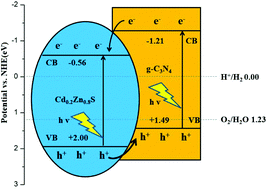Hybridization of Cd0.2Zn0.8S with g-C3N4 nanosheets: a visible-light-driven photocatalyst for H2 evolution from water and degradation of organic pollutants†
Abstract
Novel visible-light-driven Cd0.2Zn0.8S/g-C3N4 inorganic–organic composite photocatalysts were synthesized by a facile hydrothermal method. The prepared Cd0.2Zn0.8S/g-C3N4 composites were characterized by X-ray diffraction (XRD), X-ray photoelectron spectroscopy (XPS), Fourier transform infrared spectroscopy (FT-IR), transmission electron microscopy (TEM), high-resolution transmission electron microscopy (HRTEM), ultraviolet-visible diffuse reflection spectroscopy (DRS), photoluminescence (PL) spectroscopy and photoelectrochemical (PEC) experiments. Under visible-light irradiation, Cd0.2Zn0.8S/g-C3N4 photocatalysts displayed a higher photocatalytic activity than pure g-C3N4 and Cd0.2Zn0.8S for hydrogen evolution and degradation of pollutants, and the optimal g-C3N4 content was 20 wt%. The optimal composite showed a hydrogen evolution rate of 208.0 μmol h−1. The enhancement of the photocatalytic activity should be attributed to the well-matched band structure and intimate contact interfaces between Cd0.2Zn0.8S and g-C3N4, which lead to the effective transfer and separation of the photogenerated charge carriers. Furthermore, the Cd0.2Zn0.8S/g-C3N4 photocatalysts showed excellent stability during photocatalytic hydrogen evolution and degradation of pollutants.


 Please wait while we load your content...
Please wait while we load your content...